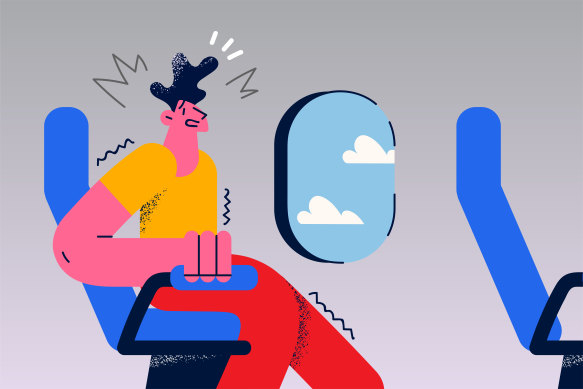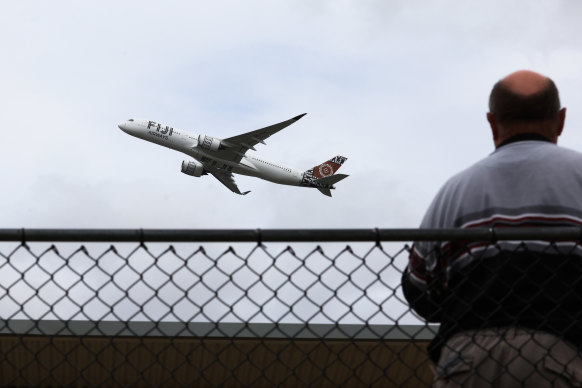Help! Stories about severe turbulence have made me too scared to fly
By Nell Geraets
In the past three months, two commercial flights have made emergency landings because of severe turbulence. The first event, in May during a Singapore Airlines flight from London to Singapore, resulted in one death and several injuries. The second, an Air Europa flight from Madrid to Montevideo in July, left over 30 people injured.
Such severe turbulence is generally rare; however, instances appear to be on the rise. Last year, British researchers found that for any average point over the Atlantic, severe “clear-air turbulence” (meaning no clouds are in sight) increased by 55 per cent between 1979 and 2020.

Severe turbulence may be getting worse, but that doesn’t mean our anxiety needs to.Credit: Adobe Stock
Thanks to climate change, this is expected to worsen. A 2017 study predicted severe turbulence will become two to three times more common over the North Atlantic by 2050 to 2080. Meanwhile, it could increase by about 50 per cent over Australia.
The reporting of these incidents can be graphic, such as passengers being “thrown around” the cabin, causing broken arms and cranial fractures. Are reports of severe turbulence, and its increasing frequency, intensifying some people’s fear of flying, aka aviophobia? And if they are, how can they tackle it on their next flight?
How do I know if I have aviophobia?
Principal clinical psychologist at the Sydney Phobia Clinic Dr Corrie Ackland says about 40 per cent of people living in industrialised countries experience some form of aviophobia, including milder anxiety. However, up to 20 per cent have a “severe fear” of flying.

Aviophobia is very common, but it can present in different ways.Credit: Getty Images
Someone with mild to moderate aviophobia may still go on flights, but could experience a racing heart, dizziness, nausea, disorientation and breathlessness. Someone with more severe aviophobia may avoid flying altogether, says clinical psychologist Dr Les Posen, who specialises in treating aviophobia.
“In 2024, the big deal is not so much crashing, it’s about the issue of control and discomfort,” Posen says. “Their fear is also often co-morbid with another fear like claustrophobia, fear of heights, agoraphobia. Flying just encapsulates all these fears in one place.”
Though no recent studies have examined whether rates of aviophobia have increased this year, Posen says incidents like the Air Europa emergency landing tend to trigger an increase in patient referrals.
The news has terrified me. What should I do?
Turbulence is one of the most commonly feared aspects of flying, Ackland says, so it’s understandable that recent news stories have triggered increased anxiety for some.
“It’s rarely reported that turbulence does not pose a risk to [passenger safety], or even if it is, it’s often an element of the story which is overlooked by anxious fliers who tend to maximise aspects of threat and minimise aspects of safety,” she says.
The best way to combat this is to educate yourself about aviation, says Todd Lane, a University of Melbourne professor who specialises in aviation meteorology and turbulence.
“Air travel is among the safest forms of transport and is much safer than travelling in a car,” Lane says. “Turbulence events where multiple passengers are injured are rare, and only occur a handful of times per year globally.”
Turbulence occurs when an aircraft passes through regions where the wind is moving chaotically, including upwards and downwards, Lane explains. This causes small changes in flight altitude, which passengers may feel as bumps.
“Methods to avoid turbulence have improved dramatically over the last few decades,” Lane says. “This includes improved weather forecasts of turbulence and better observations of storms.”
What can I do before, and during, my flight?
Ackland says visiting the airport, or plane watching, before a flight can help ease your worries. For more intensive preparation, there are fear of flying courses, in which pilots teach people about flying safety and turbulence.
“Being prepared and leaving sufficient time removes extra stress and time pressure from the existing anxiety,” Ackland says. “Try not to avoid the idea of flying, but rather make sure that thoughts of flying are helpful and accurate, rather than catastrophic and unrealistic.”
While in the air, Posen suggests using positive self-talk, which can distance yourself from a stressful situation. He also suggests listening to music with a good beat while lightly bouncing in your chair.
“What you’re doing is separating your movements from what the plane is doing. Let the plane do what it has been designed to do, which is manage itself in turbulence. If you grip your seat every time the plane goes through turbulence, you’re reactive, which means your sense of loss of control is accentuated. You want to remain independent of the plane.”
The most important strategy, however, is to wear your seatbelt. “More than 97 per cent of turbulence-related injuries are people who aren’t wearing their seatbelt,” Lane says. “This means that a well-secured seatbelt is highly effective at preventing injuries.”
Make the most of your health, relationships, fitness and nutrition with our Live Well newsletter. Get it in your inbox every Monday.